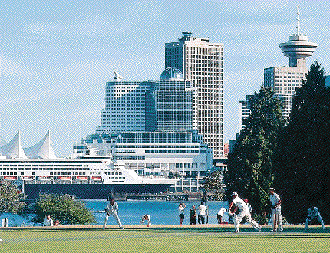|
The
planning challenges for the 2010 Games are
enormous. Here's how lines on paper and
dreams in organizers' hearts will become
real
It has
been 18 months since the International
Olympic Committee and a collection of B.C.
municipalities, sports organizations and
community supporters embarked on one of
the most ambitious cooperative sporting
exercises in Canadian history.
Much has
happened in the young life of the
Vancouver 2010 Winter Games since IOC
president Jacques Rogge and
representatives of Vancouver and Whistler
fixed their signatures to a contract
during a summertime ceremony at the Hilton
Hotel in Prague.
 The
heady euphoria of displacing two equally
competent bids from Austria and South
Korea in an act that galvanized Canadians
around the world has given way to a more
pragmatic and hard reality: 78 months is
not an awful lot of time in which to
organize the Games. The
heady euphoria of displacing two equally
competent bids from Austria and South
Korea in an act that galvanized Canadians
around the world has given way to a more
pragmatic and hard reality: 78 months is
not an awful lot of time in which to
organize the Games.
Today,
only 60 of those months remain before the
parade of nations will march into B.C.
Place Stadium to open the 17-day Olympics,
which will precede the
Paralympics.
There
is still so much to do.
Not one
drop of concrete needed for any of the
massive new venues has been poured. The
ground in the pristine Callaghan Valley,
site of the Nordic ski jumping and sliding
centres, has not been broken. The curling
venue dreamed of for Riley Park is still
just that. The aging ice hockey arenas at
the University of B.C. have yet to be
replaced.
Across
B.C., billions of dollars of non-Olympics
construction
Although
Olympics-related construction projects are
in the public eye, hundreds of others are
planned or underway throughout British
Columbia -- especially in the Lower
Mainland -- and helping to heat up the
construction industry. Here are some of
the bigger ones:
The
creative plans for how the Games will take
place are all on paper, reams and reams of
paper, and in binary files of organizers'
and consultants' computers scattered
between Vancouver, Montreal, Calgary,
Toronto and the seat of the IOC, Lausanne,
Switzerland.
They are
also lodged in the brains and hearts of
people like John Furlong, the de facto
soul of the Vancouver Organizing Committee
(Vanoc), and a small squadron of senior
executives and planners who are slowly and
methodically putting together what they
hope will be a lasting Canadian
legacy.
Almost
everything is rolling off according to the
plans. And yet the road over the past year
and a half has not been wholly smooth.
There have been some brilliant
achievements, such as the record-breaking
$200-million sponsorship deal Vanoc cut
with Bell Canada, a deal so rich that it
covers twice over what the organizers
thought they'd get from all top-tier
sponsors combined.
And the
small team of senior executives Furlong
has surrounded himself with appear to be
copies of the Energizer Bunny. They arrive
in their West Pender Street offices early
in the morning and they keep going until
late into the night. The air miles they've
clocked in trips to Switzerland, Italy,
China, Toronto and Montreal as they search
out guidance from those who have gone
before them, and to implement the
contractual demands of the IOC, likely
represent the year's profits of a small
airline company.
This week,
for example, Furlong was in Victoria on
Monday, in Williams Lake and Quesnel on
Thursday, and Prince George on Friday.
Today he's in Whistler to officiate at the
official five-years-out Vanoc
celebrations.
Vanoc is
still a small organization, with fewer
than 80 people working for it. By
Games-time, there will be nearly 1,200,
along with as many as 25,000 volunteers.
Each of the vice-presidents have multiple
responsibilities, and they're having to
make Solomon-like choices every day. It's
not possible to delegate responsibilities
to a staff you don't yet have.
Historic
building boom meets
inflation
Organizers
of the 2010 Winter Olympic Games officials
may have to turn to cheaper venue designs
as British Columbia enters what might be
the biggest building boom in its history
and double-digit inflation hits
construction costs, a senior industry
official says.
Building
the dream: From the Vancouver and Richmond
to Whistler and beyond, billions of
dollars will go into the 2010 Games. The
schedule is complex, the work daunting.
Here are the major projects
VANCOUVER
-- Vancouver Olympic
Village
Vancouver
and Area Links
Footloose
in Vancouver's Historic
Gastown
Recently
arrived for a cruise or convention? Just
steps from Canada Place, where
Alaska-bound cruise ships berth, Gastown
begins.
Footloose
in Stanley Park, the Beaches and English
Bay:
A
sea of umbrellas one moment, local
denizens decked in everything from
beachwear to high fashion the next.
Footloose
on Robson
Street:
Robson
Street is often compared to Hollywood's
Rodeo Drive, and its stores keep late
Footloose
at Granville
Island:
You
could spend a day easily.
Footloose
on Vancouver's
Waterfront:
Ed
Anderson covers the Air harbour and port
with exciting photos and items.
Footloose
on Vancouver's Elevated
Railway
SkyTrain
and SeaBus provide a Supermall 15 miles
long.
Footloose
on an Old Fashioned
Streetcar
Street
Cars, Street Scenes, Street Smarts:
Vancouver's Rail Renaissance.
Footloose
at Vancouver International
Airport
A
classy shopping mall and a convention
hotel all in one complex
.
Footloose
on Vancouver's North Shore and West
Van
Footloose
on Lonsdale
Quay
Vancouver
Convention
Centre:
Exciting
things are happening right now at the
waterfront. Take a look.
BC
Scene
Magazine:
New
web site featuring Economic Development,
Travel and Tourism in British
Columbia-Yukon and Cascadia
(Washington-Oregon)
Tourism
Vancouver's Main Website
http://www.tourism-vancouver.org/docs/visit/
Visitors
requiring assistance for accommodation can
call:
Tourism
British Columbia's 1.800.HELLOBC Tourism
Vancouver's Visitor InfoCentre on Burrard
Street.
604.683.2000World66
Vancouver Guide: http://www.world66.com/vancouver/htm
|

